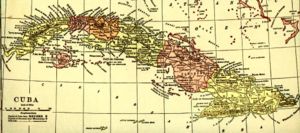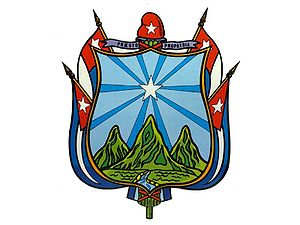
Oriente
Encyclopedia


Provinces of Cuba
Administratively, Cuba is divided into 15 provinces and one special municipality not included in any province. The last modification was approved in August 2010 , splitting Havana province into two new provinces: Artemisa and Mayabeque...
until 1976. It was known as "Santiago de Cuba Province" before 1905. The name is still used to refer to the eastern part of the country. The provincial capital was Santiago de Cuba
Santiago de Cuba
Santiago de Cuba is the second largest city of Cuba and capital city of Santiago de Cuba Province in the south-eastern area of the island, some south-east of the Cuban capital of Havana....
. Fidel
Fidel Castro
Fidel Alejandro Castro Ruz is a Cuban revolutionary and politician, having held the position of Prime Minister of Cuba from 1959 to 1976, and then President from 1976 to 2008. He also served as the First Secretary of the Communist Party of Cuba from the party's foundation in 1961 until 2011...
and Raúl Castro
Raúl Castro
Raúl Modesto Castro Ruz is a Cuban politician and revolutionary who has been President of the Council of State of Cuba and the President of the Council of Ministers of Cuba since 2008; he previously exercised presidential powers in an acting capacity from 2006 to 2008...
were born there.
The province was split up in 1976, with the administrative re-adjustment proclaimed by Cuban Law Number 1304 of July 3, 1976.
The territory of "Oriente" is nowadays represented by 5 provinces:
- Las Tunas ProvinceLas Tunas ProvinceLas Tunas is one of the provinces of Cuba. Major towns include Puerto Padre and Amancio, as well as the capital, Victoria de Las Tunas ....
- Granma ProvinceGranma ProvinceGranma is one of the provinces of Cuba. Its capital is Bayamo. Other towns include Manzanillo and Pilón.-History:...
- Holguín ProvinceHolguín ProvinceHolguín is one of the provinces of Cuba, the third most populous after Ciudad de la Habana and Santiago de Cuba. It lies in the northeast of the country. Its major cities include Holguín , Banes, Antilla, Mayarí, and Moa....
- Santiago de Cuba ProvinceSantiago de Cuba ProvinceSantiago de Cuba Province is the second most populated province in the island of Cuba. The largest city Santiago de Cuba is the main administrative center...
- Guantánamo ProvinceGuantánamo ProvinceGuantánamo is the easternmost province of Cuba. Its capital is also called Guantánamo. Other towns include Baracoa. The province surrounds the U.S. Navy base at Guantánamo Bay.-History:...
History
Diego Velazquez founded the capital of Oriente province in 1514 and named it Santiago de Cuba. The province is made up by 22 municipalities and is Cuba’s largest province containing about one third of the country’s population. Oriente Province is in the most eastern region of Cuba with a population of 1,797,606. It stretches across 14641 square miles (37,920 km²) and consists of various mountain ranges with the Sierra MaestraSierra Maestra
Sierra Maestra is a mountain range that runs westward across the south of the old Oriente Province from what is now Guantánamo Province to Niquero in southeast Cuba, rising abruptly from the coast. Some view it as a series of connecting ranges , which joins with others extending to the west...
region having Cuba’s highest mountain peak and elevation in Pico Turquino. Oriente Province holds much of Cuba’s history being the place of Fidel and Raul Castro’s birth, Jose Marti
José Martí
José Julián Martí Pérez was a Cuban national hero and an important figure in Latin American literature. In his short life he was a poet, an essayist, a journalist, a revolutionary philosopher, a translator, a professor, a publisher, and a political theorist. He was also a part of the Cuban...
was killed in battle in Dos Rios and many guerilla wars have also taken place in Oriente like the Bay of Pigs
Bay of Pigs
The Bay of Pigs is an inlet of the Gulf of Cazones on the southern coast of Cuba. By 1910, it was included in Santa Clara Province, and then instead to Las Villas Province by 1961, but in 1976, it was re-assigned to Matanzas Province, when the original six provinces of Cuba were re-organized into...
. Cuba’s first Guerilla-style war was in 1523. against the conquering Spaniards in the Sierra Maestra
Sierra Maestra
Sierra Maestra is a mountain range that runs westward across the south of the old Oriente Province from what is now Guantánamo Province to Niquero in southeast Cuba, rising abruptly from the coast. Some view it as a series of connecting ranges , which joins with others extending to the west...
Mountains. Some of Cuba’s oldest cities are in Oriente Province like Baracoa and carry a rich history of Cuba’s struggle for independence and racial relations.
Throughout the 1800s a large amount of slaves were brought to Cuba to help work at the sugar mills. Many slaves were brought from Haiti and other neighboring islands because they were cheap and efficient labor. Open warfare broke out after an independence movement and lasted from 1867 to 1878. Slavery was finally ended on 1886, but life for many Afro-Cubans was still a struggle especially in Oriente Province.
After the occupation of the Spaniards ended in 1899, Oriente Province became a refuge to Afro-Cubans. Oriente had the highest number of individual land owners and renters with 96% of the population being native born. Afro-Cubans made up 26% of the land workers and of the total land owned by Afro-Cubans 75% were in Oriente Province. Even though Afro-Cubans fared better in Oriente, poverty was still rapid in the Province and they were still an oppressed by wealthy Cubans and foreign land owners.
Sugar and coffee were the main agricultural products produced and at the highest there were forty one sugar mills spread throughout the reign. Foreign investors saw prime opportunity within the province and began to buy as much land as possible increasing sugar production. As investors bought land, local farmers were pushed out and frustration built. Poverty grew and by May 1912 Cubans in Oriente Province had reached a boiling point. Massive demonstrations broke out and Afro-Cubans began to loot and burn businesses and property owned by foreign investors. As a result, the Cuban government answered by sending the Army in to burn the property of the Afro-Cubans and to slaughter them. Within two years, half of the sugar mills in Oriente were owned by U.S. investors and for the Cubans working within the Province life became almost unbearable.
Municipalties
Present day municipalitiesMunicipio
Municipio and Município are terms used for country subdivisions. They are often translated as municipality.-Overview:...
that were part of Oriente include in Granma Province, in Guantánamo Province, in Holguín Province, in Las Tunas and in Santiago de Cuba Province.

